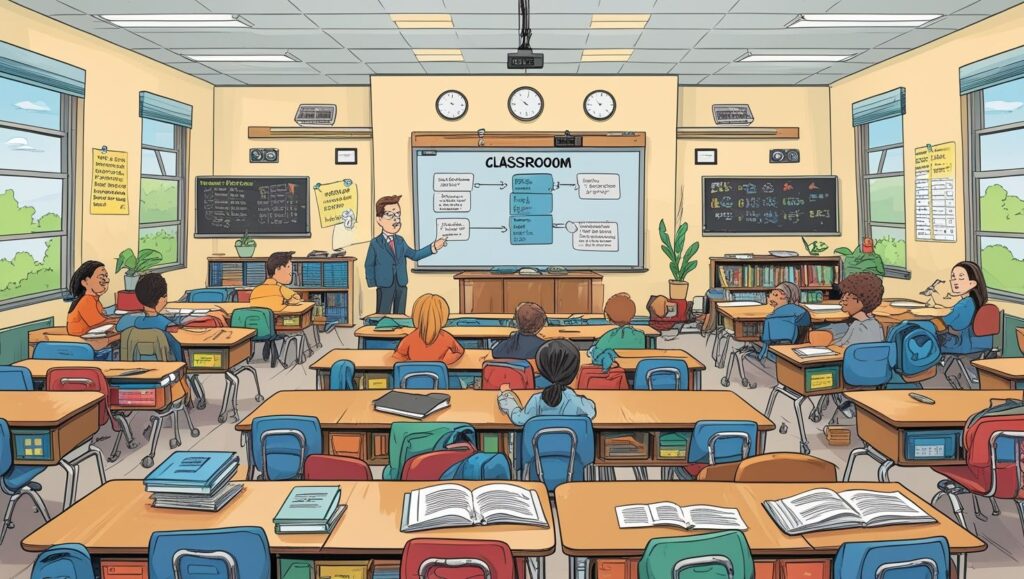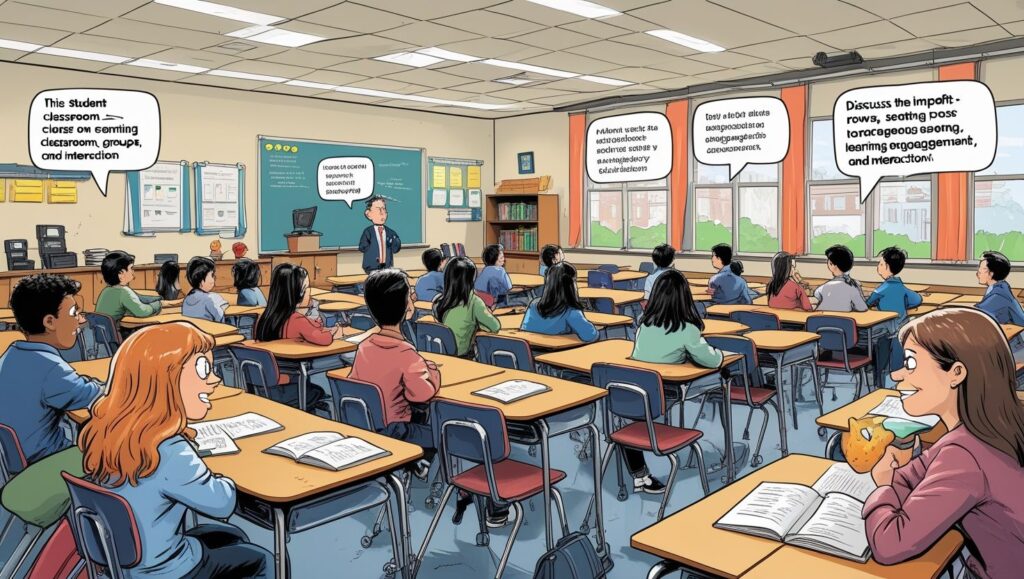Introduction
Classroom Seating Arrangements on Learning and Engagement, Classroom seating arrangements play a crucial role in shaping the learning environment, influencing student engagement, collaboration, and academic performance. Over the years, educators have experimented with various seating configurations—from traditional rows to modern flexible seating—to optimize classroom dynamics. The right arrangement can enhance teacher-student interaction, foster peer learning, and accommodate diverse learning styles.
This article explores different types of classroom seating arrangements, their advantages and disadvantages, and their impact on student behavior and learning outcomes. Additionally, it examines how seating arrangements have evolved and provides recommendations for teachers to choose the best layout based on their instructional goals.
1. Traditional Row Arrangement (Lecture Style)
Description:
The traditional row arrangement, also known as the “lecture style,” consists of desks or tables arranged in straight lines facing the front of the classroom, where the teacher typically stands. This setup has been the standard in many schools for decades.
Advantages:
- Minimizes Distractions: Rows help maintain order and reduce off-task behavior since students face forward.
- Ideal for Lectures and Exams: Effective for teacher-centered instruction, note-taking, and test-taking.
- Easy to Manage: Teachers can easily monitor all students and maintain discipline.
Disadvantages:
- Limited Interaction: Discourages peer collaboration and group discussions.
- Passive Learning: Students may become disengaged if the teaching style is not dynamic.
- Less Inclusive: Does not accommodate students who need mobility or prefer collaborative learning.
Best For:
- High school and college lecture halls.
- Standardized testing environments.
- Teacher-centered instructional approaches.
2. Cluster or Group Seating Arrangement
Description:
In this setup, desks are grouped together in small clusters (usually 4-6 students per group) to facilitate teamwork and discussion.
Advantages:
- Encourages Collaboration: Promotes peer learning, group projects, and social interaction.
- Develops Communication Skills: Students practice teamwork, negotiation, and problem-solving.
- Flexible for Activities: Ideal for project-based learning and interactive lessons.
Disadvantages:
- Noise and Distractions: Increased chatter can lead to off-task behavior.
- Unequal Participation: Some students may dominate while others remain passive.
- Challenging for Classroom Management: Requires clear rules and teacher monitoring.
Best For:
- Elementary and middle school classrooms.
- Cooperative learning strategies.
- Classrooms emphasizing discussion and teamwork.

3. U-Shaped or Horseshoe Arrangement
Description:
Desks or tables are arranged in a semicircle or U-shape, facing the front of the classroom.
Advantages:
- Encourages Discussion: Creates an inclusive environment where students can see and interact with each other.
- Better Teacher Visibility: The teacher can maintain eye contact with all students.
- Ideal for Presentations and Debates: Facilitates open discussions and public speaking.
Disadvantages:
- Takes Up More Space: Not suitable for small classrooms.
- Limited Group Work: Less effective for small-group activities unless rearranged.
Best For:
- Class discussions, debates, and Socratic seminars.
- Smaller class sizes.
- Subjects requiring frequent interaction (e.g., language arts, social studies).
4. Pair Seating (Buddy System)
Description:
Students sit in pairs, either side by side or facing each other.
Advantages:
- Encourages Peer Learning: Students can discuss concepts and help each other.
- Reduces Isolation: Shy students may feel more comfortable working with one partner.
- Easier Than Large Groups: Less chaotic than group seating.
Disadvantages:
- Potential for Off-Task Behavior: Pairs may chat about non-academic topics.
- Dependent on Partner Compatibility: Conflicts may arise if pairs don’t work well together.
Best For:
- Partner reading, think-pair-share activities.
- Classrooms with limited space.

5. Flexible Seating
Description:
A modern approach where students choose from various seating options (e.g., bean bags, standing desks, floor cushions, stools).
Advantages:
- Supports Different Learning Styles: Kinesthetic learners benefit from movement.
- Increases Engagement: Students feel more comfortable and autonomous.
- Encourages Responsibility: Students learn to choose seating that helps them focus.
Disadvantages:
- Requires Clear Guidelines: Without structure, some students may misuse freedom.
- Cost and Space Constraints: Not all schools can afford multiple seating options.
Best For:
- Elementary classrooms and innovative learning spaces.
- Schools promoting student-centered learning.
6. Stadium Seating (Chevron Style)
Description:
Desks are angled in a V-shape, allowing all students to see the front clearly.
Advantages:
- Better Visibility: No student has a blocked view.
- Semi-Collaborative: Allows some peer interaction while maintaining focus on the teacher.
Disadvantages:
- Less Effective for Group Work: Still leans toward teacher-centered instruction.
- Takes Up Space: Requires a larger classroom.
Best For:
- Classrooms where visibility (e.g., demonstrations, slideshows) is important.
Factors to Consider When Choosing a Seating Arrangement
- Classroom Size: Some arrangements (like U-shape) require more space.
- Student Age: Younger students may benefit from clusters, while older students may need rows for exams.
- Teaching Style: Lecture-based vs. discussion-based lessons require different setups.
- Student Behavior: Noisy classes may need more structured seating.
- Lesson Objectives: Group work, presentations, and tests each demand different arrangements.
Conclusion
Classroom seating arrangements significantly impact student engagement, behavior, and learning outcomes. There is no one-size-fits-all solution; the best arrangement depends on the teacher’s goals, student needs, and classroom dynamics. Educators should experiment with different layouts and remain flexible to adapt to their students’ evolving needs. By thoughtfully arranging seating, teachers can create an environment that maximizes learning, collaboration, and student success.

3 thoughts on “Classroom Seating Arrangements on Learning and Engagement”
Comments are closed.